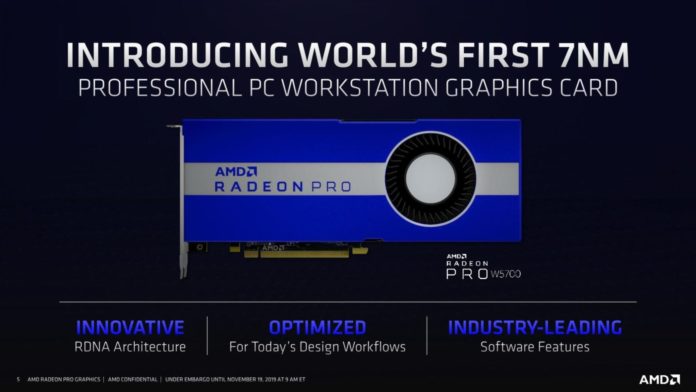Back at CES when AMD unveiled its RDNA architecture “designed specifically for gamers”, I had the feeling that team red was going to redesign its gaming lineup using the new Navi GPU and keep GCN for compute oriented workstation graphics. However, it seems like AMD intends to use RDNA across the board in both consumer GPUs as well as workstations. The world’s first 7nm Professional graphics card was today revealed in the form of the Radeon Pro W5700.
Technically speaking, it seems to be the same as the Radeon RX 5700 packing the same 36CUs and 8GB of GDDR6 memory paired with a 256-bit bus. The only difference is with respect to the TDP and the core clock. The W5700 has a much higher boost clock of 1930MHz (the RX 5700 tops out at 1725MHz) but this extra performance comes at the cost of a higher TDP. While the RX 5700 has a power rating of 180W, the W5700 is rated up to 205W. However, we know that the load TDP will be much higher than that. I reckon the W5700 might come close to the 300W mark as the RX 5700 draws as much as 230W under load.
| Graphics Card Name | Radeon Pro WX 7100 | Radeon Pro WX 8200 | Radeon RX 5700 | Radeon Pro W5700 |
|---|---|---|---|---|
| GPU | Polaris 10 | Vega 10 | Navi 10 | Navi 10 |
| Process Node | 14nm | 14nm | 7nm | 7nm |
| Compute Units | 36 | 56 | 36 | 36 |
| Stream Processors | 2304 | 3584 | 2304 | 2304 |
| ROPs | 32 | 64 | 64 | 64 |
| Clock Speed (Peak) | 1243 MHz | 1500 MHz | 1725 MHz | 1930 MHz |
| VRAM | 8 GB GDDR5 | 8 GB HBM2 | 8GB GDDR6 | 8 GB GDDR6 |
| Memory Bus | 256-bit | 2048-bit | 256-bit | 256-bit |
| Memory Bandwidth | 224 Gbps | 484 Gbps | 448 Gbps | 448 Gbps |
| TDP | 150W | 230W | 180W | 205W |
| Price | $799 | $999 | $349 | $799 |

Compared to the older Vega WX 8200, AMD is promising an average performance advantage of up to 41% (per watt). Looking at the power profile of the consumer Navi 10 cards, this falls in line with what we’ve already seen in gaming workloads. Considering that the W5700 is clocked higher by 200MHz, it’ll be interesting to see how much of a difference will it cause with respect to the average power consumption.




Compared to NVIDIA’s Quadro RTX 4000, the W5700 performs more or less on par in most applications while drawing the same level of power. Of course, the Quadro will still have a big advantage in applications that leverage the RTCores for BVH acceleration and the Tensors for AI-related workloads but it is pricier too. Furthermore, for traditional workloads that don’t take utilize NVIDIA’s candies will see the W5700 perform roughly the same as the Quadro RTX 4000 while costing a good $200 less.
Further reading:


